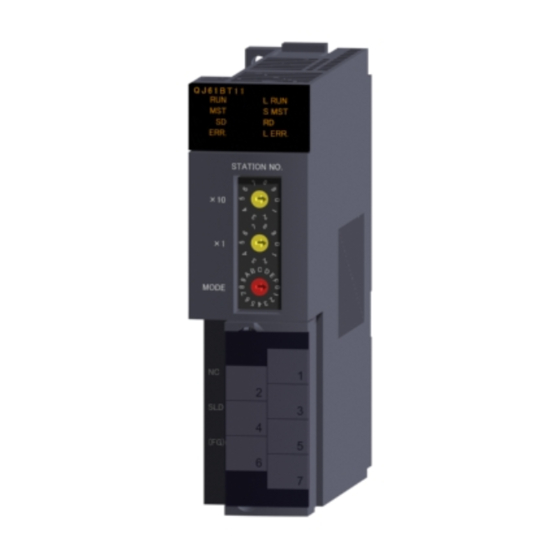
Table of Contents
Advertisement
Quick Links
Advertisement
Table of Contents

Summarization of Contents
Conditions of Use for the Product
Mitsubishi Programmable Controller Usage Conditions
Conditions for using the PLC to prevent serious accidents and ensure fail-safe functions.
Prohibited Applications
List of applications where the product should not be used without authorization.
Introduction to ST Programming
1.1 What is the ST Language?
Defines ST language, its features like text format, operators, and functions.
1.2 Features of ST Program in MELSEC-Q/L Series
Details efficiency, restoration, online changes, multi-language support, and function groups.
1.3 ST Program Creating Procedure
Outlines the general ST programming workflow from project creation to debugging.
System Configuration for ST Programs
2.1 System Configuration Overview
Explains the system configuration for ST program usage.
2.1.1 Applicable CPUs
Lists the CPU modules compatible with ST programs.
2.1.2 Programming Tool for ST Program
Specifies the software package and environment for ST programming.
2.1.3 ST Program Specifications
Explains ST specifications and applicable devices, including program size.
Handling Characters and Numeric Values
3.1 Usable Characters
Details the characters, symbols, and their locations of application in ST programs.
3.2 Data Handling
Defines the types of data used in ST programs and their representation methods.
3.2.1 Data Types
Lists and defines data types like BOOL, INT, DINT, REAL, STRING, ARRAY, STRUCT.
3.2.2 About ANY Type
Explains the ANY type for functions that permit multiple data types for arguments or return values.
3.2.3 Array and Structure
Explains how arrays and structures are used as data in ST programs.
3.3 Data Representation Methods
Explains constants, labels, and devices used as data in ST programs.
3.3.1 Constants
Details how constants are represented in ST programs (Binary, Octal, Hexadecimal).
3.3.2 Labels
Explains the use of labels for data in ST programs, requiring declaration before use.
3.3.3 Devices
Explains how devices of QCPU/LCPU can be used directly in ST programs without labels.
ST Program Expressions
4.1 Assignment Statement
Explains the function of assigning an expression's result to a label or device.
4.2 Operators
Lists usable operators in ST programs and their priorities.
4.3 Control Syntaxes
Covers conditional statements and repeat statements for comparison and repetition.
4.3.2 Conditional Statements
Explains conditional statements for controlling program execution based on conditions.
4.3.3 Repeat Statement
Covers repeat statements for executing code multiple times based on conditions.
4.4 Call of Function Block
Explains how to use user-created Function Blocks (FBs) in ST programs.
4.5 Comment
Explains how to input comments in ST programs using '(*' and '*)' delimiters.
MELSEC Functions
How the Functions Are Described
Explains the manual's format for describing MELSEC functions: definitions, arguments, return values, examples.
5.1 Output Functions
Details functions for outputting data to devices.
5.2 1-Bit Shift
Covers functions for shifting data by one bit.
5.3 Termination Functions
Functions for stopping program execution.
5.4 Comparison Operation
Details functions for comparing data blocks.
5.5 Arithmetic Operation
Details arithmetic operations like addition, subtraction, multiplication, and division.
5.6 Data Conversion
Covers functions for converting data between different formats.
5.7 Data Transfer
Covers functions for transferring data between devices.
5.8 Program Execution Control
Functions for controlling program execution, such as interrupts.
5.9 I/O Refresh
Functions for refreshing I/O devices.
5.10 Logical Operation Commands
Covers logical operations like AND, OR, XOR.
5.11 Rotation
Functions for rotating bits within data.
5.12 Shift Functions
Functions for shifting data bits.
5.13 Bit Processing
Functions for setting, resetting, and testing bits.
5.14 Data Processing
Functions for searching and analyzing data.
5.15 Structuring
Functions related to structuring intelligent function modules.
5.16 Buffer Memory Access
Functions for reading and writing to buffer memory.
5.17 Character String Processing
Functions for manipulating character strings.
5.18 Special Functions
Trigonometric and other special mathematical functions.
5.19 Data Control
Functions for controlling data based on limits or dead bands.
5.20 Clock Functions
Functions for reading and writing clock data.
5.21 Program Control
Functions for controlling program execution status.
5.22 Others
Miscellaneous functions, including watchdog timer reset.
IEC Functions
How the Functions Are Described
Explains the manual's format for describing IEC functions: definitions, arguments, return values, examples.
6.1 Type Conversion Functions
Functions for converting data between types like BOOL, INT, DINT, REAL, STRING.
6.2 Numerical Functions (General Functions)
General numerical functions like absolute value and square root.
6.3 Numeric Functions (Logarithm Functions)
Logarithm functions including natural logarithm and exponent.
6.4 Numerical Functions (Trigonometric Functions)
Trigonometric functions like SIN, COS, TAN, and their inverse operations.
6.5 Arithmetic Operation Functions
Functions for performing arithmetic operations like addition, multiplication, subtraction, division, and modulus.
6.6 Bit Shift Functions
Functions for shifting bits within data.
6.7 Bit Type Boolean Functions
Logical operations on bit type Boolean data.
6.8 Selection Functions
Functions for selecting data based on a condition.
6.9 Comparison Functions
Functions for comparing data values.
6.10 Character String Functions
Functions for manipulating character strings.
Error List
Conversion Error List
Lists errors occurring during ST program conversion with causes and corrective actions.
Appendices
Appendix 1: Character Strings Not Usable as Labels/FB Names
Lists character strings that cannot be used for labels and FB names in ST programming.
Appendix 2: ST Instruction Table for GX Developer and GX Works2
Compares ST instructions usable in GX Developer vs. GX Works2.
Warranty Information
Gratis Warranty Term and Range
Details the warranty period and scope for product failures.
Onerous Repair Term After Discontinuation of Production
Specifies repair acceptance period after product production discontinuation.
Overseas Service
Information on obtaining repairs through Mitsubishi's overseas FA Centers.
Exclusion of Loss in Opportunity and Secondary Loss
Mitsubishi's liability limitations regarding consequential damages.
Changes in Product Specifications
Disclaimer regarding potential changes in product specifications.
Product Application
Conditions for applying the MELSEC controller, excluding high-risk applications.












Need help?
Do you have a question about the MELSEC-l and is the answer not in the manual?
Questions and answers